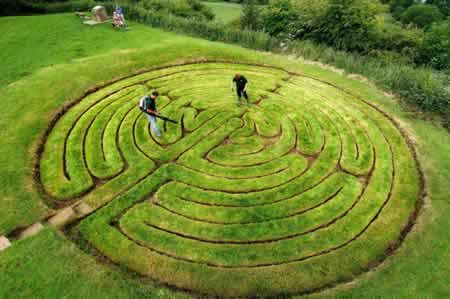Labyrinths, Circles and Dance by Jim Snee
 From memory, which I must confess is somewhat distant, dance has never played a significant part in the church services I have attended if any part at all. Which is a shame, because dance has a long tradition in Christianity and has played a significant part in Christian celebrations.
From memory, which I must confess is somewhat distant, dance has never played a significant part in the church services I have attended if any part at all. Which is a shame, because dance has a long tradition in Christianity and has played a significant part in Christian celebrations.
To understand this, I took some time to read about the church that existed before the split between east and west in the early 11th century, when all things Byzantine were the vogue. It is easy to forget, here in our dark northern mists that Christianity is a religion of the eastern Mediterranean.
An interesting physical reminder of this use of labyrinth in meditation, teaching and celebration. Classicists are inclined to place all labyrinths into the tradition of Theseus and the minotaur, but the tradition is much wider and spreads across North Africa, the Palestine land bridge, Asia Minor and the Balkans. It was certainly taken up by the Byzantine church and incorporated into a mosaics and paintings. The tradition appears to have established itself in the western church.
The most famous Christian labyrinth is at Chartres Cathedral in France and in its present form is believed to date to the early 13th century. Records from the cathedral show that the labyrinth was used for meditation and for contemplating Christ’s journey through life and death. It is also used for celebratory dances, the most important of which is known as the resurrection dance. In this, the Priest dances to the centre of the labyrinth while the congregation forms a circle around the edge. Held in the priest’s hand is a ball of wool, and once at the centre, said to symbolise death, the priest throws the ball to a member of the congregation, whilst holding the end of the wool. The ball is thrown back, and then out again in a different direction, back and forth until all the wool is unwound and the priest is in the centre of many radiating strands. The symbolism, it is claimed, is that Christ has conquered death not for himself, but for all. The final stage is for the congregation to dance in a circle around the labyrinth.
This may seem a little distant from Lincolnshire, but the tradition can be found, in a modified form, in the county. At the northwest corner of Lincolnshire is the village of Alkborough. There, on a hilltop overlooking the confluence of the Trent and the Ouse, is a medieval turf maze, a labyrinth similar in style to that of Chatres Cathedral. It is often said that the turf mazes were for peasant entertainment, but that does a disservice to the piety of ordinary people and the way in which religion was inseparable from everyday life. As for the resurrection dance, I remember children dancing in a circle, holding ribbons that radiated out from a May Pole, in celebration of spring and natures rebirth – in memory of the resurrection dance?
I have written before on the ancient and instinctive nature of dance, but by reading and studying contemporary illustrations we can learn about the traditions and perhaps even the origins of medieval dance, and its successors. Circle dances, or Carole as they are known, are well-illustrated, and were described as joyous, with the ladies trying to out-perform each other. Another form of dance is the Chain Dance, where one person leads a line (or chain) of dancers “a merry dance” through twists and turns and even spirals. Both of these would suit a labyrinth well.
Curiously there is also an account of solo dancing that represents the labyrinth. It may have originally been performed by women and may have eastern Mediterranean origins. We know about this because of an account deriding medieval sailors who engaged in this “unmanly” form of dance that was “full of twists and turns as if imitating the spirals of the labyrinth.”
Today, we might categorise such dances as belly dance, which has its own and rather convoluted history. The origins are ancient and have evolved into dance traditions that can be found across southern Europe and North Africa. In Britain, its historic use tends to be limited to migrant communities of eastern origin, until the 20th century. Then, like in most of the western world, it was hijacked by Orientalism and given a particularly bad reputation by the Dutch dancer Mata Hari, and others. After WW2 there was a renaissance in belly dance in America and western Europe, with a strong drive towards authenticity. In the 1960s, the rise of the Renaissance Fair in America prompted American dancers to research medieval connections with belly dancing, particularly focusing on north African dance. This became the basis of tribal belly dance, and appropriately, has brought us full circle. In the 21st Century we celebrate a tradition of dancing that has linked us to the eastern Mediterranean and North Africa for over a thousand years and links our present to our past.
History, alive in labyrinth, circle and dance.
